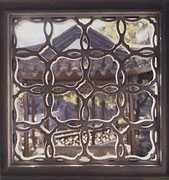
|
TO
THE TEACHER
OBJECTIVES OF THIS UNIT:
: To introduce students to the Chinese
garden as an art form. To help students understand the literati
elite not just in terms of their connections to government service
and Confucian learning, but also in relation to notions of
elegance.
TEACHING STRATEGIES: This
material is suitable to a comparative approach. Students can
compare not only western gardens to Chinese gardens, but western
luxury residences (palaces, country houses, mansions) to the
gardens and homes built by Chinese with means and taste.
Another
good approach to this unit is to link gardens to other key
elements of Chinese civilization, such as aesthetic principles
also found in landscape painting, ideas associated with Daoism
concerning paradises and immortals, and the social life of the
literati elite.
WHEN
TO TEACH:
In a chronologically-organized course, Gardens should not
be taught before the Ming dynasty, when these sorts of gardens
became an important part of the life of the elite, at least in the
Jiangnan area. If
both Homes and Gardens are used in the class, it would be better
to do Homes first as it introduces concepts elaborated on in
Gardens. This unit
could also be used in a course on Chinese art. |

Xie Huan, Elegant Gathering in the Apricot Garden
(detail)
| SOURCE: Zhongguo
meishu quanji, Huihua 6:
Mingdai huihua, shang (Beijing: Wenwu chubanshe, 1988), pl.
42, p. 49. Collection of the National Palace Museum, Taipei.
Xie Huan (Ming, active
1368-1437 AD), An Elegant Gathering in the Apricot Garden. This is
the third section of a handscroll executed in ink and colors on
silk. The painting depicts a gathering organized by Yang Rong, one
of the Grand Secretaries under Ming Xuanzong. Yang Rong invited
eight other high-ranking ministers to his garden to enjoy
themselves composing poetry, viewing paintings, and playing chess. |
|
|
Garden design was an art in China. One of the most common ways to make a Chinese home more
elegant was to develop one or more compounds into a garden with plants, rocks,
and garden buildings. Gardens were especially appreciated for their great beauty
and naturalness. In time, garden design came to be regarded as a refined
activity for the well-heeled and well-educated.
It may be useful to note that what we are calling a garden in China is
somewhat different from its counterpart in western Europe or the United States.
It is not an expanse of green with incidental buildings, but rather an area in
which buildings surround arrangements of rocks, plants and water; without these
buildings, the Chinese garden is not a garden. The architectural elements
themselves are decorative and structure how one views the scenery. Good views
are many and intimate in scale, in contrast with the sweeping vistas and
mathematically ordered plantings of European gardens of the same period. The
enclosure of the entire compound by walls or other natural barriers marks this
area off as a special precinct for private enjoyment.
Gardens were an important part of the homes of the elite long before Ming
times, but reached their fullest development in the late Ming in the Jiangnan
area, which comprised the southeastern part of China south of the Yangtze River,
including the densely-populated cultural centers of Yangzhou, Hangzhou, and
Suzhou. These gardens served multiple purposes for their owners. They were
extensions and developments of a family's property; they added cultural value by
providing a pleasurable environment for private relaxation and entertaining
friends and colleagues. In some cases they also contained a productive
agricultural portion in the form of orchards or fields for cash crops that could
support the needs of a large extended family. But most gardens were luxury items
that demonstrated and enhanced the status of their owners.
As you look at the images in this section, keep in mind the following
questions:
 | How does the garden relate to the courtyard-style home in terms of
structure and design? |
 | What differences between the house and garden made the garden a desirable
addition to the elegant home? |
 | What types of activities or events were more likely to take place in the
garden as opposed to the house, and why? |
 | How did the ways to make homes more elegant and impressive differ in China
and Europe? |
 |
 |
|
Origin |

|
|
Design |

|
|
Social Uses |

|
|
Aesthetics |

|
|
Tour |
|
|
